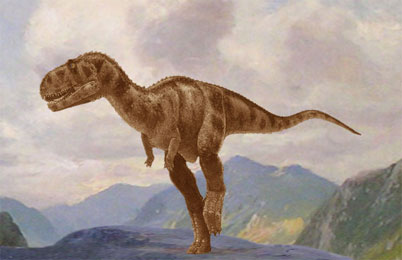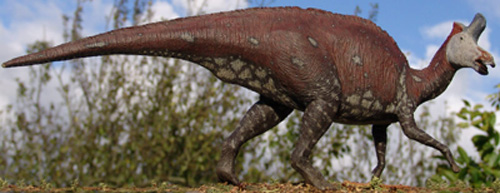ACHELOSAURUS
| NAME: |
Meaning - Achelosaurus means "lizard"
Pronounced - ah-BEL-i-SAWR-us
Named By - Jack Horner and F. E. Novas
When Named - 1995 |
| DIET: |
Carnivore (meat-eater) - it ate plant-eating dinosaurs. |
| SIZE: |
Length - 21 to 26 feet (6.5 to 7.9 m) long
Height - 6.6 ft (2 m) tall at the hips
Weight - 1.4 tons |
| WHEN IT LIVED: |
Late Cretaceous period, about 75-70 million years ago |
| WHERE IT LIVED: |
Fossils have been found in Rio Negro Province, Argentina, South America. |
| FOSSILS: |
Abelisaurus is known from a single skull that is 33 inches (85 cm) long. |
| CLASSIFICATION: |
- Kingdom Animalia (animals)
- Phylum Chordata (having a hollow nerve chord ending in a brain)
- Class Archosauria (diapsids with socket-set teeth, etc.)
- Order Saurischia - lizard-hipped dinosaurs
- Suborder Theropoda - bipedal carnivores
- Family Neoceratosauria
- Genus Abelisaurus
- Species A. comahuensis (type species named by Bonaparte and Novas, 1985)
|
INTERESTING
FACTS: |
Abelisaurus was a primitive theropod (meat-eating dinosaur) with a big head, a rounded snout, and relatively small teeth. |
Abelisaurus (Abelisaurus comahuensis), meaning
"Abel's lizard", was a type of dinosaur.
It was discovered by Othenio Abel, the director of the Argentinian
Museum of Natural Science, and named by J.F. Bonaparte and F.E.
Novas in 1985.
Abelisaurus Dinosaur
English name: "Abel's lizard"
Food: Flesh
Living period: Late Cretaceous
Finding places: Argentina
Length: 9 m. (27 ft.)
Short Description: The Abelisaurus was a Ceratosaur and related to the Carnotaurus. It walked on two legs 
Abelisaurus has been establish in Rio Negro in
Argentina, and is supposed to have lived around 75 to 70 million
years ago, during the late Cretaceous period. It is known from a
single incomplete, 33-inch (85 cm) long skull. It had strangely
heavy teeth, and thus was possibly in part a scavenger.
Abelisaurus was a bipedal carnivore, a primitive theropod, standing roughly 6.6 feet
(2 metres) tall at the hips, 21 to 26 feet (almost 8 meters) long
and weighing 1.4 tons. Large fenestrations (window-like openings)
in the Abelisaurus's skull meant that its skull was lighter than
most dinosaurs.Abelisaurus may have been connected to carnotaurus,
which also lived in Argentina over 70 million years ago, and perhaps
to indosuchus.
|

